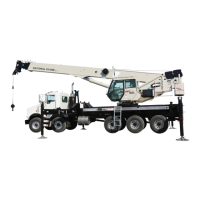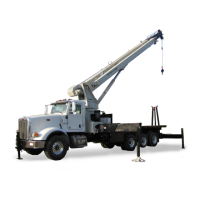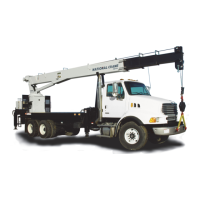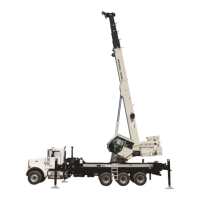SAFETY PRECAUTIONS - CRANE NBT40-1 SERIES OPERATOR MANUAL
2-24
3-29-2018 Control # 610-00
• Proximity devices are advertised to detect the existence
of electricity and not its quantity or magnitude.
• Some proximity devices may detect only alternating
current (AC) and not direct current (DC).
• Some proximity devices detect radio frequency (RF)
energy and others do not.
• Most proximity devices simply provide a signal (audible,
visual, or both) for the operator; this signal must not be
ignored.
• Sometimes the sensing portion of the proximity devices
becomes confused by complex or differing arrays of
power lines and power sources.
Do not depend on grounding. Grounding of equipment
affords little or no protection from electrical hazards. The
effectiveness of grounding is limited by the size of the
conductor (wire) used, the condition of the ground, the
magnitude of the voltage and current present, and numerous
other factors.
Electrical Contact
If the equipment should come in contact with an energized
power source, you must:
1. Stay in the equipment work station. Don’t panic.
2. Immediately warn personnel in the vicinity to stay away.
3. Attempt to move the equipment away from the contacted
power source using the equipment’s controls which are
likely to remain functional.
4. Stay in the equipment until the power company has been
contacted and the power source has been de-energized.
No one must attempt to come close to the equipment or
load until the power has been turned off.
Only as a last resort should an operator attempt to leave the
equipment upon contacting a power source. If it is absolutely
necessary to leave the lower operator’s station, jump
completely clear of the equipment. Do not step off. Hop
away with both feet together. Do not walk or run.
Following any contact with an energized electrical source,
the National Crane distributor must be immediately advised
of the incident and consulted on necessary inspections and
repairs. Thoroughly inspect the rope and all points of contact
on the equipment. Should the distributor not be immediately
available, contact Manitowoc Crane Care. The equipment
must not be returned to service until it is thoroughly
inspected for any evidence of damage and all damaged parts
are repaired or replaced as authorized by your National
Crane distributor or Manitowoc Crane Care.
Special Operating Conditions and
Equipment
Never operate the equipment during an electrical
thunderstorm.
When operating near transmitter/communication towers
where an electrical charge can be induced into the
equipment or load:
• The transmitter shall be de-energized OR,
• Tests shall be made to determine if an electrical charge
will be induced into the equipment or load.
• The equipment must be provided an electrical ground.
• If taglines are used, they must be non-conductive.
• Every precaution must be taken to dissipate induced
voltages. Consult a qualified RF (radio frequency)
Consultant. Also refer to local, state, and federal codes
and regulations.
When operating equipment equipped with electromagnets,
you must take additional precautions. Permit no one to touch
the magnet or load. Alert personnel by sounding a warning
signal when moving a load. Do not allow the cover of the
electromagnet power supply to be open during operation or
at any time the electrical system is activated. Shut down the
equipment completely and open the magnet controls switch
prior to connecting or disconnecting magnet leads. Use only
a non-conductive device when positioning a load. Lower the
magnet to the stowing area and shut off power before
leaving the operator’s cab (if equipped) or operator’s station.
Grounding the Crane
The crane may become charged with a buildup of static
electricity. This may occur especially when using synthetic
material in the outrigger floats or cribbing such as plastic or
when the outrigger floats are packed with insulating material
(e.g. wooden planks).
The crane may be grounded using electrically conducting
material for grounding to prevent buildup of static electricity.
WARNING
Risk of accidents due to electric shock!
Ground the crane before you start to work with it
• Near strong transmitters (radio transmitters, radio
stations, etc.)
• Near high-frequency switching stations
• If a thunder storm is forecast

